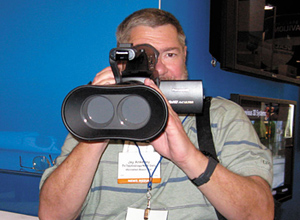Will New Year of 3D Drive Lens Technology?

3D. We’re all going to hear “3D” in 2010 until it’s coming out our ears. I think it can be a good thing for the TV and video industry. And I think there’s something good in it for you and me as well.
What’s driving 3D right now? It’s a counter-offensive by the movie theater owners. As homes install huge screens and awesome sound systems, and as true high-resolution content is being delivered by Blu-Ray, cable, satellite and IPTV, theater owners have found something that people can’t get in their homes yet: theatrical 3D. Witness 2009 movies “Avatar” and “Disney’s A Christmas Carol.”
At the same time, where movie producers can still argue whether shooting on film or shooting with high-resolution video systems is the best for standard motion picture fare, the maturing of high-resolution video techniques has made 3D production economically feasible.
INTEROCULAR AND CONVERGENCE
As we’re all learning, 3D calls for a pair of cameras to be placed side-by-side in what’s called a 3D rig to yield a left-eye, right-eye view of a scene. The precision of the alignment of those two cameras is vital, and likely you’ve never had a headache like the one you’ll get trying to view misaligned 3D.
Shooting 3D on film, you can align those two cameras as carefully as is humanly possible, but until you get the processed film back, you really don’t know the alignment is correct.

TV Technology Editing columnist Jay Ankeney checks out Panasonic’s proposed “3D Full HD camcorder” with fixed interocular lens configuration at the 2009 NAB Show. With video, you can check that alignment in real time, and correct it before you shoot the scene.
In both video and film, we’ve all become familiar with the terms focal length, iris, focus and zoom. With 3D, there are two additional terms we’ll have to know: interocular and convergence.
Interocular (IO) is the distance between the two cameras (or lenses). That distance determines how extreme the 3D effect is, and also will need to be varied for different focal length lenses and by the distance from cameras to the subject. 3D rigs provide for interocular adjustment.
The two cameras in the 3D rig are angled slightly toward each other so that their framing matches up exactly at some distance away. That adjustment is convergence (Conv.), and in 3D, objects in the frame at that convergence point will appear to be located at the screen.
Objects closer to the camera than that convergence point will appear to be located in front of the screen, and those further away will appear to be behind the screen.
When shooting 3D with film, experience and careful calculations are used to determine IO and Conv. And when you get the film back from the lab, you know what you actually have.
When shooting with high-resolution video, IO and Conv. can be optimized on a 3D monitor prior to shooting the scene. And for multicamera shoots, IO and Conv. can be matched among the various camera pairs, and can be adjusted in real time during the shoot.
Okay, so this is what the 3D producers are doing. I promised you there was something in it for you and me.
Number one is lens technology. The lenses on the left and right cameras in a 3D rig must match each other precisely. (Remember that headache I talked about?) Right now 3D production crews have to rely on the best of the best lenses available, and during the days of camera prep prior to shooting they mix and match lenses to get the best pairings.
HISTORY REPEATING ITSELF?
It reminds me of the early days of high-definition production, when the only lenses good enough for high-definition production were outrageously expensive. But the lens makers used what they learned in making those early HD lenses to produce more affordable high-performance lenses.
I think 3D is going to drive even more lens technology, which will trickle down to the more affordable lenses most of us use. But further than that, I think there’s going to be a role for 3D production at the local level.
Where, until recently, 3D rigs and other equipment associated with 3D production were available only from boutique 3D production firms, they are starting to show up now in rental house inventories. The alchemy that went into 3D production is starting to become more common knowledge, and affordable 3D post is available from the same group that gave you affordable 2D post.
And it’s important to know that in the same way you can acquire and edit in HD, but deliver in SD for the time being, material acquired in 3D can be delivered in 2D by using the images from only one of the cameras, generally the left-eyed one. The 3D-ready material can sit on the shelf, ready when the customer is ready for a 3D version. And that may be sooner than you think.
January’s Consumer Electronics Show (CES) has yet to happen. Because large screen HDTV vendors want to empty their shelves of 2D screens for Christmas, they haven’t been touting their new wares yet. But I think we’re going to be hearing a lot coming out of Las Vegas about 3D big screen TVs. The game makers have been delivering 3D games for years, so though there may be a dearth of 3D video product to watch, the game machine can be plugged in and used in 3D on day-one.
That said, I close with this bet: I won’t live long enough to see the local news in 3D. And people in my family live a long time.
Craig Johnston is a Seattle-based Internet and multimedia producer with an extensive background in broadcast. He can be reached atcraig@craigjohnston.com.
Get the TV Tech Newsletter
The professional video industry's #1 source for news, trends and product and tech information. Sign up below.
